


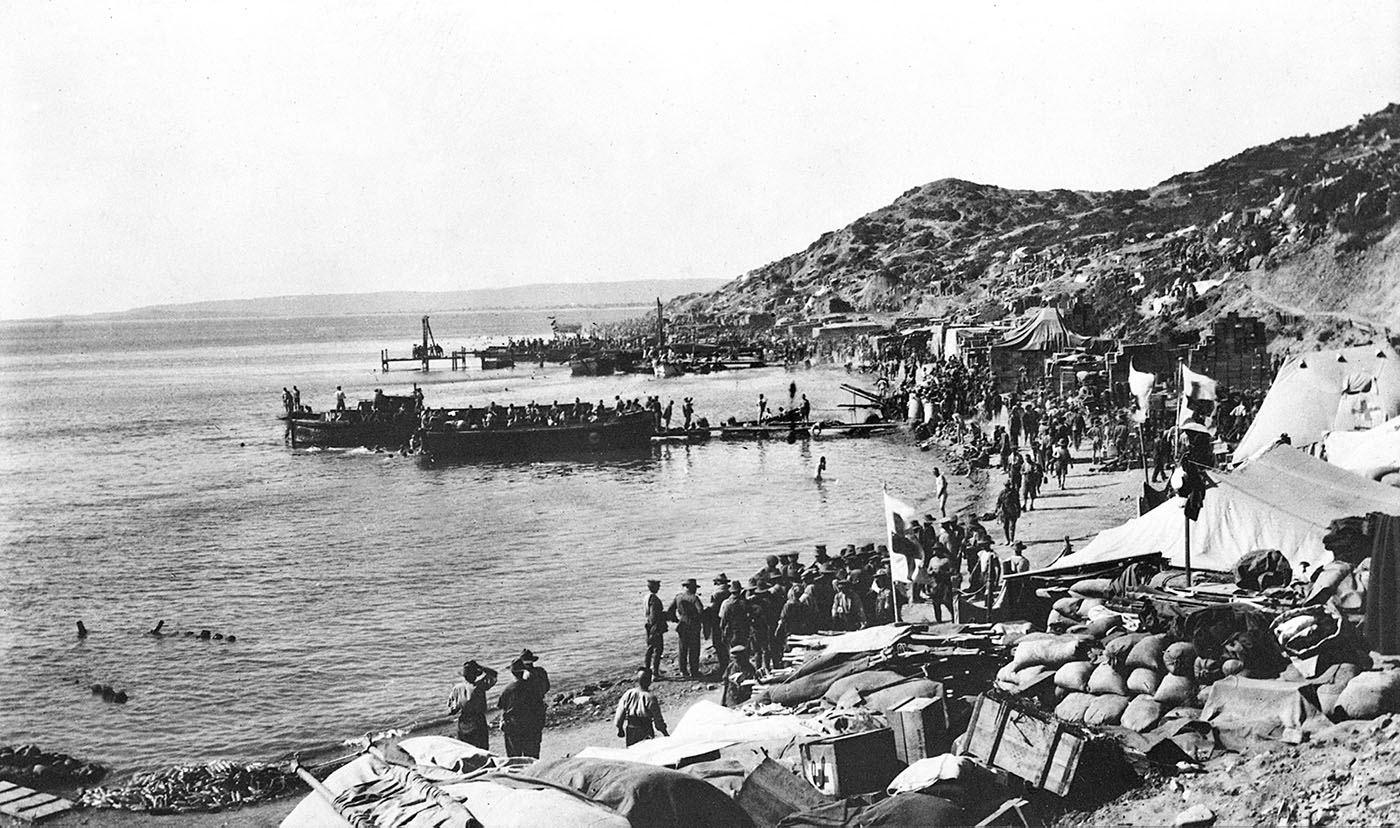 Source: Peninsula Essence
Source: Peninsula Essence
The Gallipoli campaign was a military campaign in the First World War that took place on the Gallipoli peninsula, from 17 February 1915 to 9 January 1916. The Entente powers, Britain, France and Russia, sought to weaken the Ottoman Empire, one of the Central Powers, by taking control of the Turkish straits. Though it was a failure for the Allies, Gallipoli has become a defining moment in the history of both Australia and New Zealand, revealing characteristics that both countries have used to define their soldiers: endurance, determination, initiative and 'mateship'. Read through the resources below to learn more.
At dawn on 25 April 1915, Allied troops landed on the Gallipoli peninsula in Ottoman Turkey. The Gallipoli campaign was the land-based element of a strategy intended to allow Allied ships to pass through the Dardanelles, capture Constantinople (now Istanbul) and ultimately knock Ottoman Turkey out of the war. Read through this website to learn more.
Australia's involvement with the Gallipoli Campaign began in late 1914 when the first contingent of Australian troops disembarked in Egypt. In March 1915, an Anglo-French fleet failed to sail through the Dardanelles on the Gallipoli peninsula's southern shore. The fleet had hoped to bring Constantinople under fire in an attempt to cripple Germany's ally, the Ottoman Empire. To help the navy, the Allies landed infantry on Gallipoli on 25 April 1915. Their soldiers made little headway. An attempted break out in August failed. By winter 1915, high command decided to evacuate Gallipoli. The campaign cost the Allies more than 141,00 casualties, including over 8000 Australians. Some quarter of a million men of the Ottoman Empire were killed or wounded. Read through this website for a timeline of events.
Early on the morning of 25 April 1915, Allied forces landed on the Gallipoli peninsula in Ottoman Turkey. This marked the start of the Gallipoli Campaign, a land-based element of a broad strategy to defeat the Ottoman Empire. Over 8 months, the Anzacs advanced little further than the positions they had taken on that first day of the landings. Read through this website to learn more.
On 25 April 1915 Australian soldiers landed at what is now called Anzac Cove on the Gallipoli Peninsula. For the vast majority of the 16,000 Australians and New Zealanders who landed on that first day, this was their first experience of combat. By that evening, 2000 of them had been killed or wounded. The Gallipoli campaign was a military failure. However, the traits that were shown there – bravery, ingenuity, endurance and mateship – have become enshrined as defining aspects of the Australian character. Read through this article to learn more.
The Australians landed at what became known as Anzac Cove on 25 April 1915, and they established a tenuous foothold on the steep slopes above the beach. During the early days of the campaign, the allies tried to break through the Turkish lines and the Turks tried to drive the allied troops off the peninsula. Concerted but unsuccessful allied attempts to break through in August included the Australian attacks at Lone Pine and the Nek. All attempts ended in failure for both sides, and the ensuing stalemate continued for the remainder of 1915. Read through this website to learn more.
On Saturday 5 August 2000, a special symposium Gallipoli: the August Offensive was held at the Australian War Memorial to mark the 85th anniversary of the Gallipoli campaign. A selection of the papers presented at this symposium have been reproduced on this website.
This website lists Australian fatalities by month for the Dardanelles (Gallipoli) campaign approximate (April 25, 1915 to January 8, 1916).
This website lists the awards given to Australians for services during the Gallipoli campaign.
The stories behind the nine Victoria Crosses won by Australian soldiers on the little known peninsula almost a century ago, all of which are held and displayed in the Memorial's Hall of Valour, helped in the creation of the ANZAC legend. Read through this website to learn more about their stories.
John Simpson Kirkpatrick was born in Britain but later moved to Australia. In August 1914 he enlisted in the Australian Imperial Force, serving at Gallipoli the following year as Private John Simpson in the 3rd Field Ambulance, Australian Army Medical Corps. He served from the time of the landing at Gallipoli on 25 April until he was killed in action on 19 May. Simpson became famous for his work as a stretcher-bearer. Using one of the donkeys brought in for carrying water, he transported wounded men day and night from the fighting in Monash Valley to the beach on Anzac Cove. Read through this article to learn more.
Listen to senior historian and curator Brad Manera gave a keynote address re-examining some key battles at Gallipoli, and how information about the fate of casualties was conveyed to family members back in Australia.
The Gallipoli Campaign began as an ambitious naval strategy devised by Winston Churchill, First Lord of the Admiralty, to force the Ottoman Empire out of the Great War. Following the failure of the initial attack plan, an eight month ground war ensued across the Gallipoli peninsula, characterised by a disastrous underestimation by the British, of Ottoman resistance to the invasion of their homeland. The events of April 25th 1915 formed a bitter beginning to a broader campaign which eventuated in retreat and failure for the Mediterranean Expeditionary Force. Read through this website to learn more.
Fought during the First World War (1914-18) from 25 April 1915 to 9 January 1916, Gallipoli was the first major amphibious operation in modern warfare. British Empire and French troops landed on the Ottoman-held peninsula in the Dardanelles Straits with disastrous consequences for the Allies. Read through this website to learn more.
This collection includes images of Anzac troops in Egypt and Gallipoli, some beautiful hand-tinted glass slides and a couple of popular songs from the First World War era. Australia’s baptism of fire in the First World War took place with the landings on the Gallipoli Peninsula of Turkey on 25 April 1915. The Australian Imperial Force sailed in convoy from Albany, Western Australia, landing in Egypt where they formed the Australian and New Zealand Army Corps under the command of Lieutenant-General Sir William Birdwood.
This website is a great starting place to learn some of the basics about the Gallipoli Campaign.
This website gives a brief overview of the Gallipoli Campaign and provides links to a huge collection of primary sources related to the Gallipoli Campaign.
The assault on the Gallipoli Peninsula was designed to engage Turkish forces by land and eventually push through to the Turkish capital Istanbul. Read through this website to learn more about this doomed campaign.
The only known moving images of the 1915 campaign at Gallipoli, shot mostly by English war correspondent Ellis Ashmead-Bartlett.
The Australian War Memorial holds over 300 maps from the Gallipoli campaign. The collection includes maps used at the landing of Australian and New Zealand forces at Anzac Cove on 25 April 1915, Turkish maps made during and immediately after the campaign, trench maps, operational maps, artillery maps, and Anzac cemetery plans.


Australians landing at Anzac Cove at 8am, 25 April 1915 - part of the 4th Battalion and the mules for the 26th (Jacob's) Indian Mountain Battery. In the foreground is the staff of Colonel H N MacLaurin of the 1st Infantry Brigade. The officer with the rolled greatcoat over his shoulder is Major F D Irvine (killed on 27 April). Nearer the water's edge (centre) is Captain D M King, Orderly Officer. The officer on the left, with his chinstrap down, is Lieutenant R G Hamilton, the Brigade Signal Officer. At the water's edge lies an Australian engineer (Sapper R Reynolds), the first to fall during the war.

Australian troops going into action across Plugge's Plateau after the landing on 25 April. Men in front may be seen kneeling in the scrub. The troops were under fire from the other side of Shrapnel Valley. This scene is from a Turkish trench overlooking the Anzac Cover beach.

Photograph taken from the entrance to the tunnel in which the soldiers slept.

A game of cricket being played at Shell Green - the only game of cricket played on the Gallipoli peninsula. Major George Macarthur Onslow of the Light Horse, batting, is being caught out. Shells were passing overhead all the time the game was in progress. This game was an attempt to distract the Turks from the imminent departure of Allied troops. With the exception of letter writing and sea bathing, the troops at Gallipoli had virtually no opportunity for recreation.
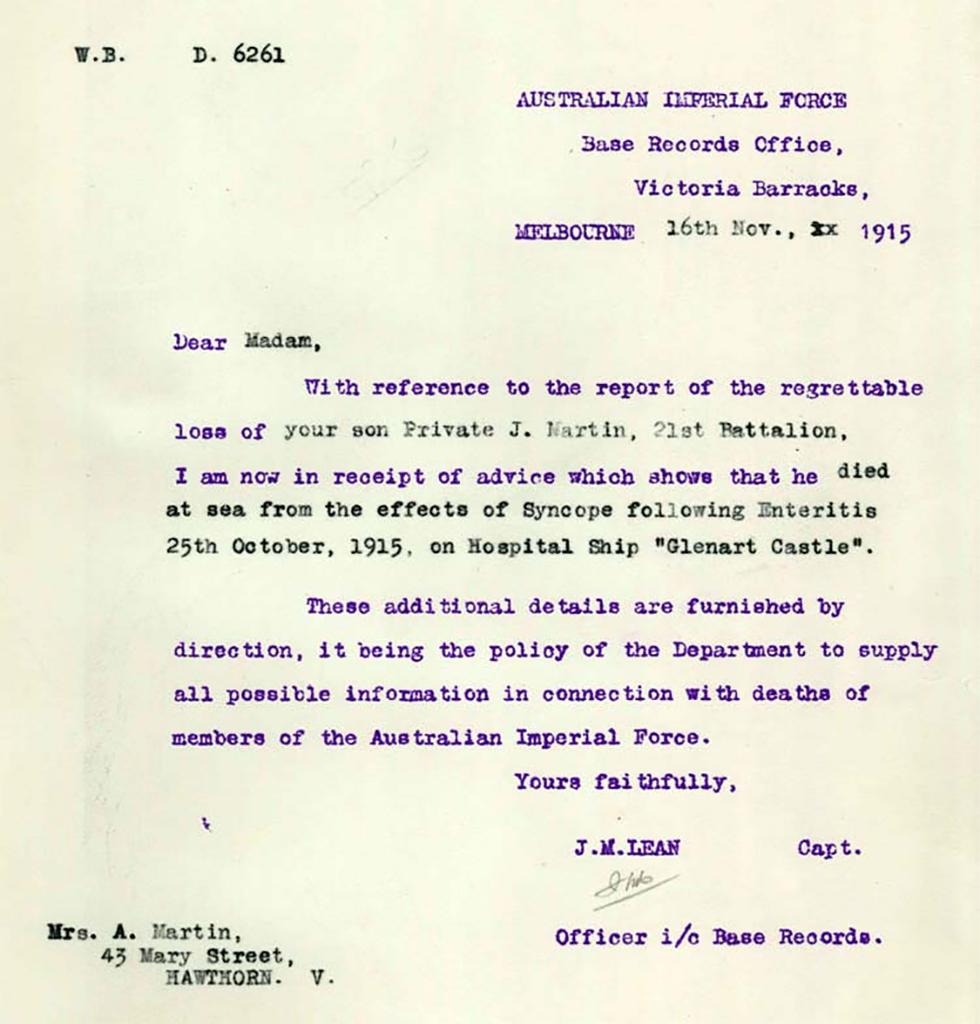
This is a letter sent to Amelia Martin giving details of the death of her only son, Private James Charles (Jim) Martin, at Gallipoli. The cause of death is given as 'Syncope following Enteritis': a coma caused by typhoid or a similar major bacterial infection of the lower intestine.
Private James Martin (Service Number 1553) is believed to be the youngest Australian to die on active service. At the time of his death, the army was under the impression that he was 18 1/2 years old. In fact, he was only 14 years and 9 months old.
Martin was born on 3 January 1901 and enlisted in the Australian Imperial Force in April 1915, three months after his 14th birthday. At his enlistment, he brought with him a three-line statement of consent signed by his mother and father. The Martin family was strongly opposed to his enlistment, but he forced them to agree by stating he would join up under a false name if they did not consent.
Martin landed at Gallipoli on 8 September 1915 as a member of the first reinforcements of the 21st Battalion. In August that year, a huge epidemic of diarrhea caused by enteritis had broken out at Gallipoli, brought about by appalling sanitation and a huge infestation of flies. In the week before Martin landed, 7.5% of the Anzac forces had been evacuated sick. Of those remaining, 78 per cent had diarrhea.
Of the 8709 Australian fatalities at Gallipoli, 665 died of disease. Martin was one of them. On 25 October 1915, less than 2 months after landing, he was evacuated by barge to a hospital ship anchored off Gallipoli. He died the same day.
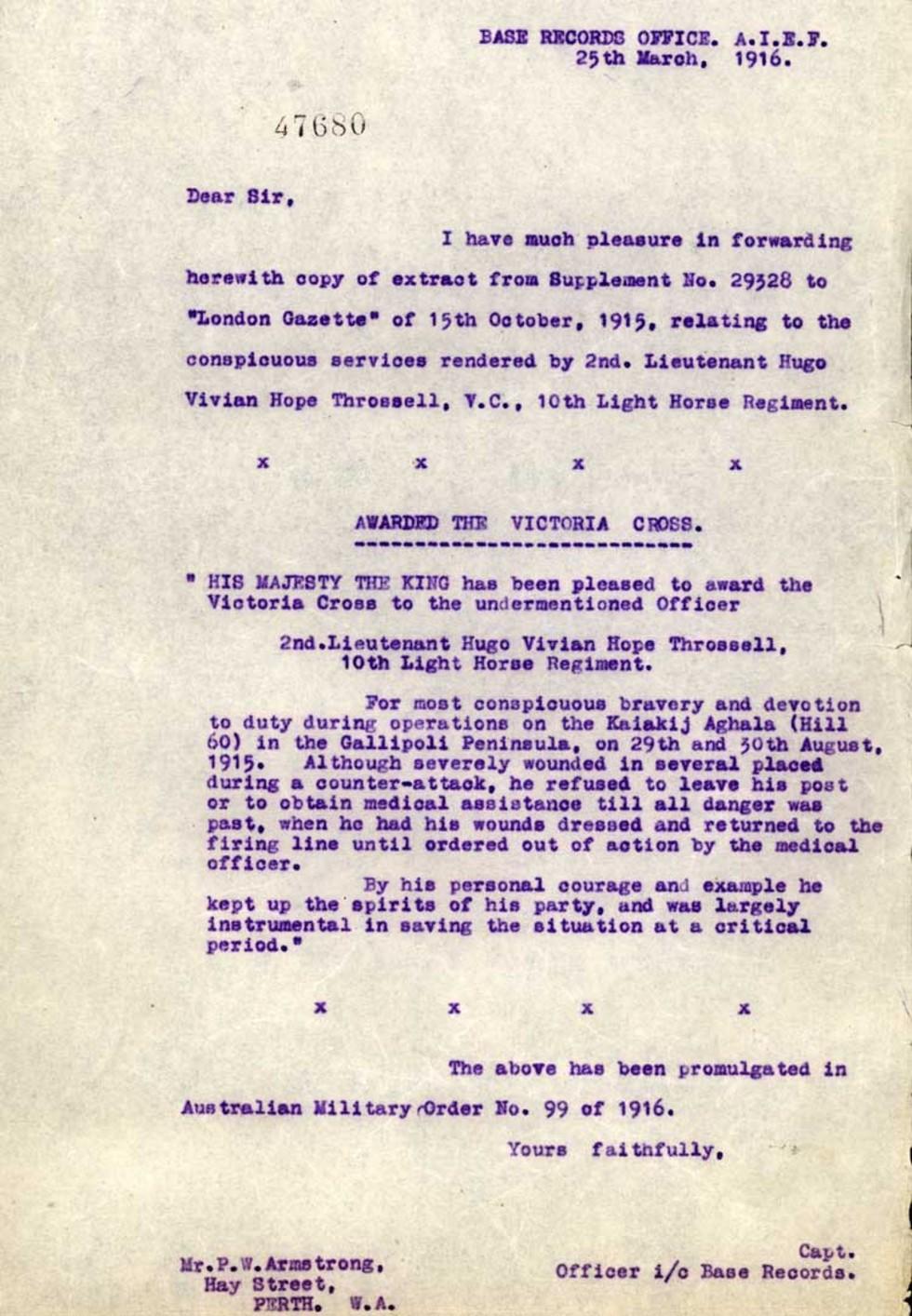
This is a letter to the next of kin of Second Lieutenant Hugo Throssell informing them that he had been awarded the Victoria Cross. The award was for ‘most conspicuous bravery and devotion to duty’ during operations on Hill 60 at Gallipoli.
Hugo Throssell enlisted in the 10th Light Horse Regiment with his brother Frank Eric (‘Ric’) in 1914. In August 1915, he fought in the battle for Hill 60 on Turkey’s Gallipoli peninsula. Hill 60 linked the British positions at Suvla with those at Anzac. It was the scene of several Allied attacks and heavy loss of life. The 10th Light Horse attack captured some of the Turkish lines but, in the end, the enemy still held much of the hill.
In a dramatic, night-long fight, Lieutenant Throssell and his men took a trench near the summit and held it. They threw back hundreds of Turkish bombs and suffered heavy casualties from multiple counterattacks.
During the battle, Throssell demonstrated great personal courage and was severely wounded. He was evacuated to Britain, where he underwent 4 months of treatment. After developing meningitis, he was repatriated to Western Australia.
Throssell returned to the front in 1917 and was wounded in Gaza, Palestine, where his brother was killed. He again recovered and continued to serve until February 1919.
After the war, Throssell became involved with pacifism, socialism and workers’ rights, speaking publicly on the futility of war. He committed suicide in 1933.
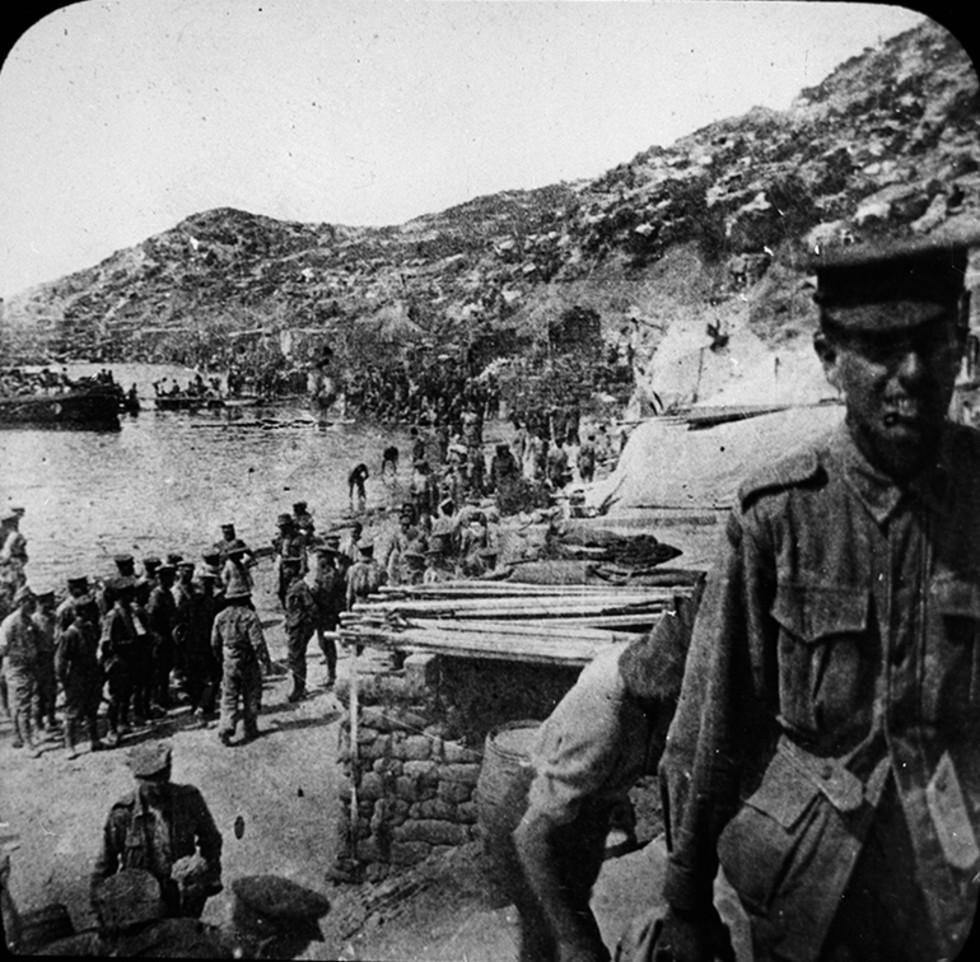
This photograph shows Australian and New Zealand Army Corps (ANZAC) troops landing at Anzac Cove, Gallipoli, in 1915.
When Britain declared war on Germany in August 1914, Australia automatically followed it into war. The Anzacs landed on the Gallipoli peninsula in Turkey on 25 April 1915 as part of the Allied force – which included British, French, Indian, Australian and New Zealand soldiers.
After the Anzacs landed, the steep ridges, deep gullies and thick scrub of the peninsula made it extremely difficult for them to move forward and attack the positions held by the Turkish soldiers. All their ammunition, water and supplies had to be landed on the narrow beach and carried up the steep hills.
The Anzacs faced challenging conditions. Under constant fire from Turkish troops, the soldiers needed to dig trenches and tunnels to protect themselves from enemy attack and to live in. Almost all became sick from diseases spread by the poor sanitation and the flies feeding off the decaying bodies.
The Anzacs – and the Turks – had only basic military equipment at Gallipoli. Their main weapons were a rifle and bayonet, used for hand-to-hand combat. They also made improvised hand grenades, the Anzac version of which were known as ‘jam-tin bombs’.
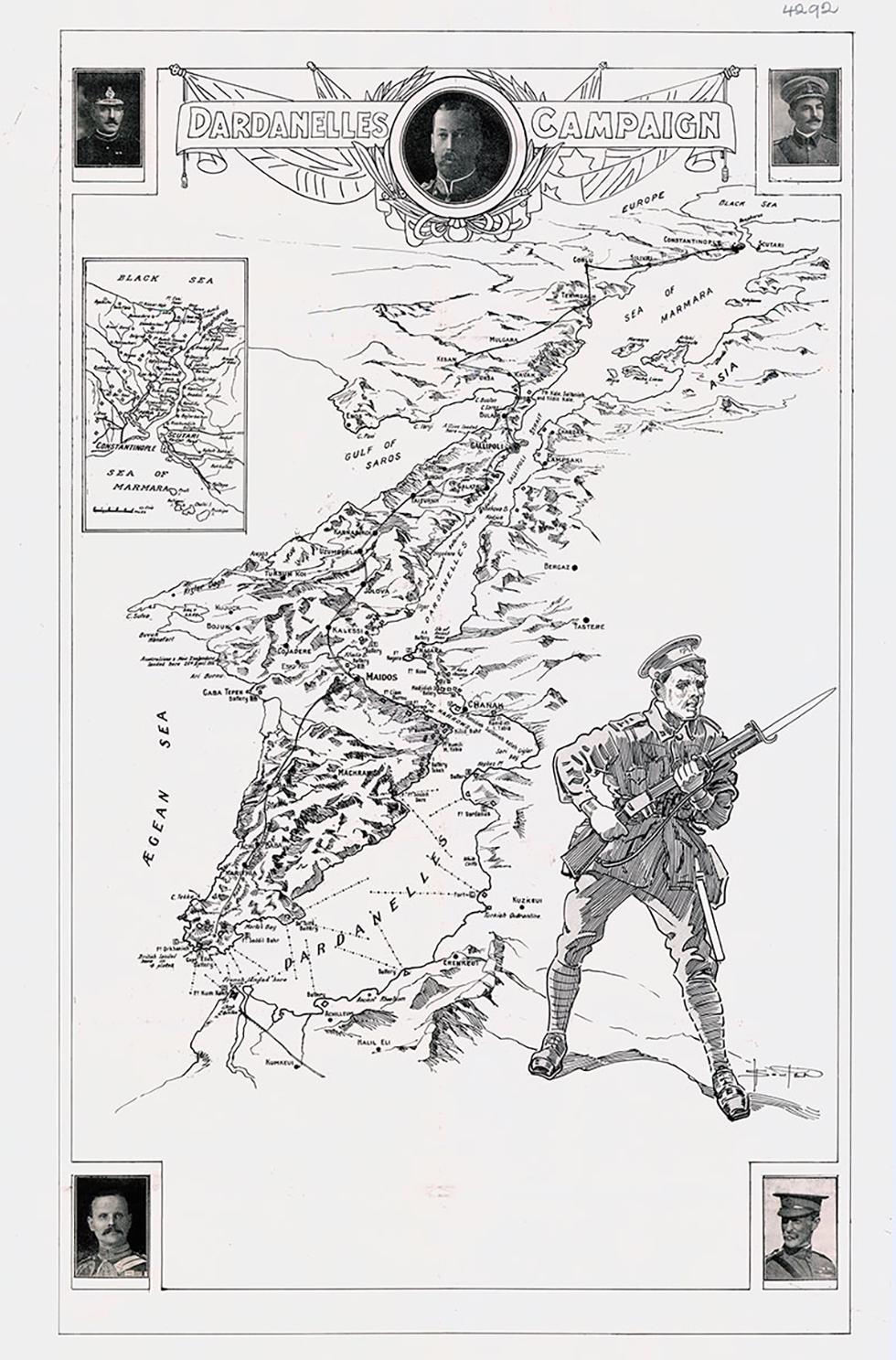
This poster shows a map of the Dardanelles campaign (another name for the Gallipoli campaign) designed by architect Edward Kerr. It features images of King George V (centre top) and senior Australian military officers involved in the Gallipoli campaign.

Identified from left: Captain Cecil Duncan Sasse, (with eyes bandaged, later Lieutenant Colonel, DSO and Bar); 2211 Private George Wood (with moustache and legs crossed); 2173 Private Martin Maher (smoking pipe); 2190 Claude Wilfred Leo Pittendrigh (hands near rifle muzzle); unidentified (in corner of frame). These men had been fighting continuously from the beginning of the Lone Pine attack on 6 August 1915.

Diary relating to the First World War service of Captain Percy Lay, 8th Battalion. The diary was kept by Captain Lay between 19 October 1914 and 31 March 1918, and covers his journey to Egypt aboard the S.S. Benalla, training in Egypt and service with the 8th battalion in Gallipoli and the Western Front. Captain Lay also describes his arrival at Ashar Barracks, Basra, Iraq in preparation for his service with Dunsterforce.

Diary relating to the First World War service of 1433 Private John Henry Llewellyn Turnbull, 8th Battalion. This is the first of six detailed diaries transcribed by Turnbull after the war, and documents his embarkation and subsequent service at Gallipoli with the 8th Battalion. This diary was originally written between February 2nd to October 31st 1915 omitting March 20th to April 3rd which is continued in his second diary.
This diary begins with his embarkation from Melbourne in February 1915, details his journey to Egypt, the island of Lemnos in early April and details the many practice beach landings and drills 'attacking' local villages in preparation for the landing at Gallipoli. He then goes on to write a detailed account of the landing on 25 April, including boats half full of wounded due to Turkish shell fire before they had even reached the shore, and early encounters with the Turkish soldiers. He was then moved down to Cape Helles with the British Soldier and details his time there, including those with the Gurkas
Upon returning to Anzac in mid-May he writes of Private John Simpson Kirkpatrick, who he called "Simmie the Donkeyman,", the details of the armistice on 24 May, the sinking of HMS Triumph, jam tin bombs, Colonel Charles Henry Brand, the prelude to and battle of Lone Pine, and his role in charge of snipers and a bomb post at Courtney's Post.
Both of his hands were damaged by shrapnel and in mid-August unable to stand up and suffering from dysentery he was evacuated to Alexandria. Turnbull's diary concludes with healing and sightseeing in Egypt.

With the Gallipoli campaign at deadlock, a smaller Allied force, including Australians and New Zealanders, made an amphibious landing at Suvla Bay on the Aegean Sea to relieve pressure on the main force. Many horses accompanied the landing parties, providing vital transport for men and material. This photograph shows men washing their horses in advance of the Suvla attack, with mules, tents and other equipment in the background.

This hand-coloured glass slide shows men swimming in or lying beside the water at ANZAC Cove, beneath Plugge’s Hill (in background).

Lieutenant General Sir William Birdwood, a senior officer in Britain’s pre-1914 Indian Army, was appointed in December 1914 to command the ANZAC forces. Birdwood has been described as the ‘Soul of Anzac’. His Corps headquarters was located in the hills just behind Anzac Cove, Gallipoli, and was open to Turkish shelling. On most days, he could also be observed swimming off the beach, sharing the dangers of Turkish shelling with everyone else.
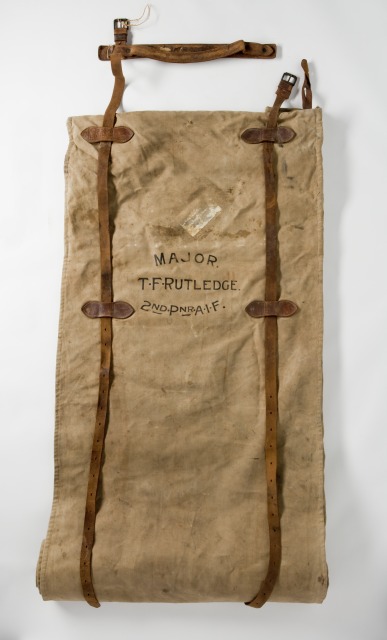
This bed roll was used by Thomas Lloyd Forster Rutledge. By the outbreak of the First World War in 1914, Rutledge was already a commissioned officer of one of Australia's oldest mounted volunteer regiments, the 3rd (later 11th) Australian Light Horse. In November 1914 he left for Egypt as a member of the 7th Light Horse of the Australian Imperial Force. Rutledge returned to Australia in December 1918, after fighting in Gallipoli, Egypt and France. He turned his attention to running sheep and cattle at Gidleigh. In 1940, with Australia again at war, Rutledge rejoined the 11th Light Horse and assisted with training new recruits at a camp on the New South Wales coast. In the intervening years, Rutledge was able to pursue his passion for trout fishing, spending time camping and fishing with friends near the Crackenback river in the Snowy Mountains in New South Wales.

This document sets out the conditions for a 9 hour armistice with the Turkish forces at Gallipoli on May 23rd 1915, by Lieutenant Colonel Skeen and Major Blamey. The purpose of the ceasefire was to allow both sides time to retrieve their dead and wounded from the battlefield.

Alfred Love was a plumber from the Melbourne suburb of Coburg. He died shortly after writing the last entry in this diary.
Transcription:
Pg 26
Thurs Apr 22nd Still on Board the Seeang Choon at Lemnos Island - nothing doing much only more boats coming in from Egypt - There is a Terrible lot of Boats here now and yet more to come - still feeling well
Fri Apr 23rd The Warships are getting ready for the fray now - all getting steam up - Some Transport (7) and 4 Battleships have gone out tonight - soon to be our turn now I hope - getting tired of the ship
Sat Apr 24th A lot more Troops left today - the Battle starts tomorrow morning in earnest at DayBreak
(Sunday) We can here (sic) the big guns firing this morning - We are now moving ourselves - 9.50 - Reached the scene of action at 5pm and landed and dug ourselves in under fire
pg 27
Mon Apr 26th Daylight now - The turks are Driven back a mile or two - very heavy losses yesterday for the Australians - about 4 hundred come on one boat last night - we are now ready in trenches and give them hell - We move right up to the firing line in the morning. The Allies are having it pretty rough but we?ll win
Tues Apr 27th Arrived at firing line at 10 oclock this morning ? having a very bad time of it so far ? machine gun played hell on our men ? for a start they were getting hit and killed all around me but I escaped so far
(Written up the side of the diary - Thinking a lot of wife and child)
pg 32
Written on inside cover: In the event of my Death I wish this book to be sent to my Dear Wife to let her know that my last thoughts were of her and Essie my darling Daughter
Address Mrs A. H Love
33 Moreland Rd
Brunswick
Melbourne
Victoria
Australia
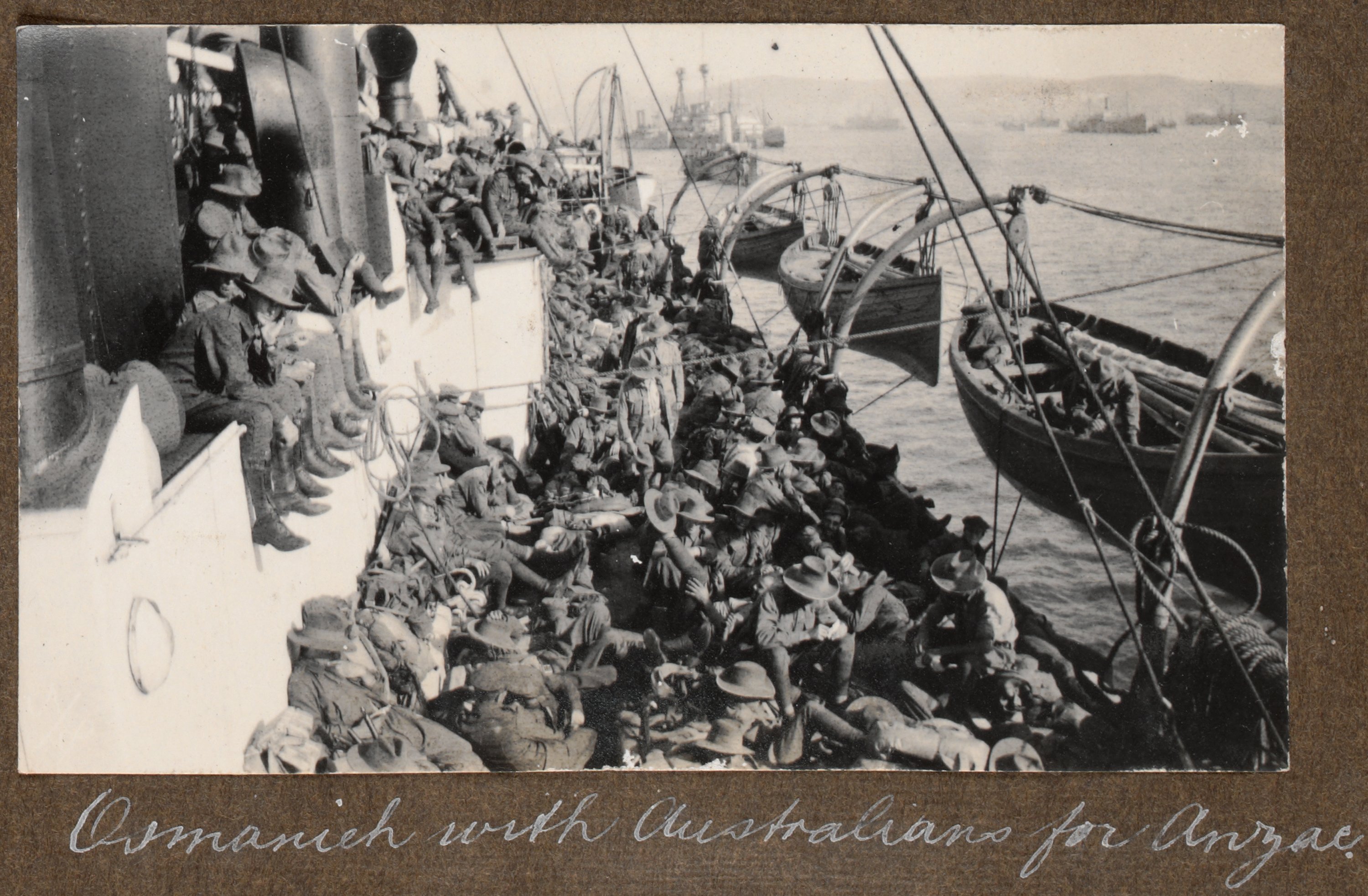
This photograph shows troops crowded aboard the transport ship Osmanieh, heading for Gallipoli in 1915. Two years later, this ship was sunk by German mines, with the loss of nearly 200 lives, including 8 nurses.
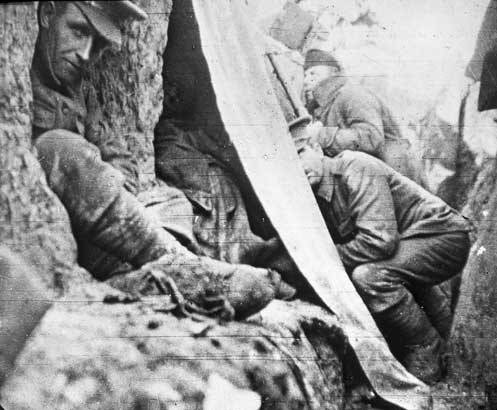
First time under fire,’ wrote Rev Bennett in his diary on 4 September 1915. ‘Ducked one’s head…slept in a shelter. Soldier moved me in. Shrapnel holes in roof. Cheerful prospect.’

‘Sunsets, mules, water carriers, lonely crosses, makes one sad,’ Rev Bennett wrote in his diary in September 1915.

Meals were cooked on open fires or paraffin stoves as far out of the line of fire as possible, although even on the beaches they were still within range of Turkish artillery and snipers.
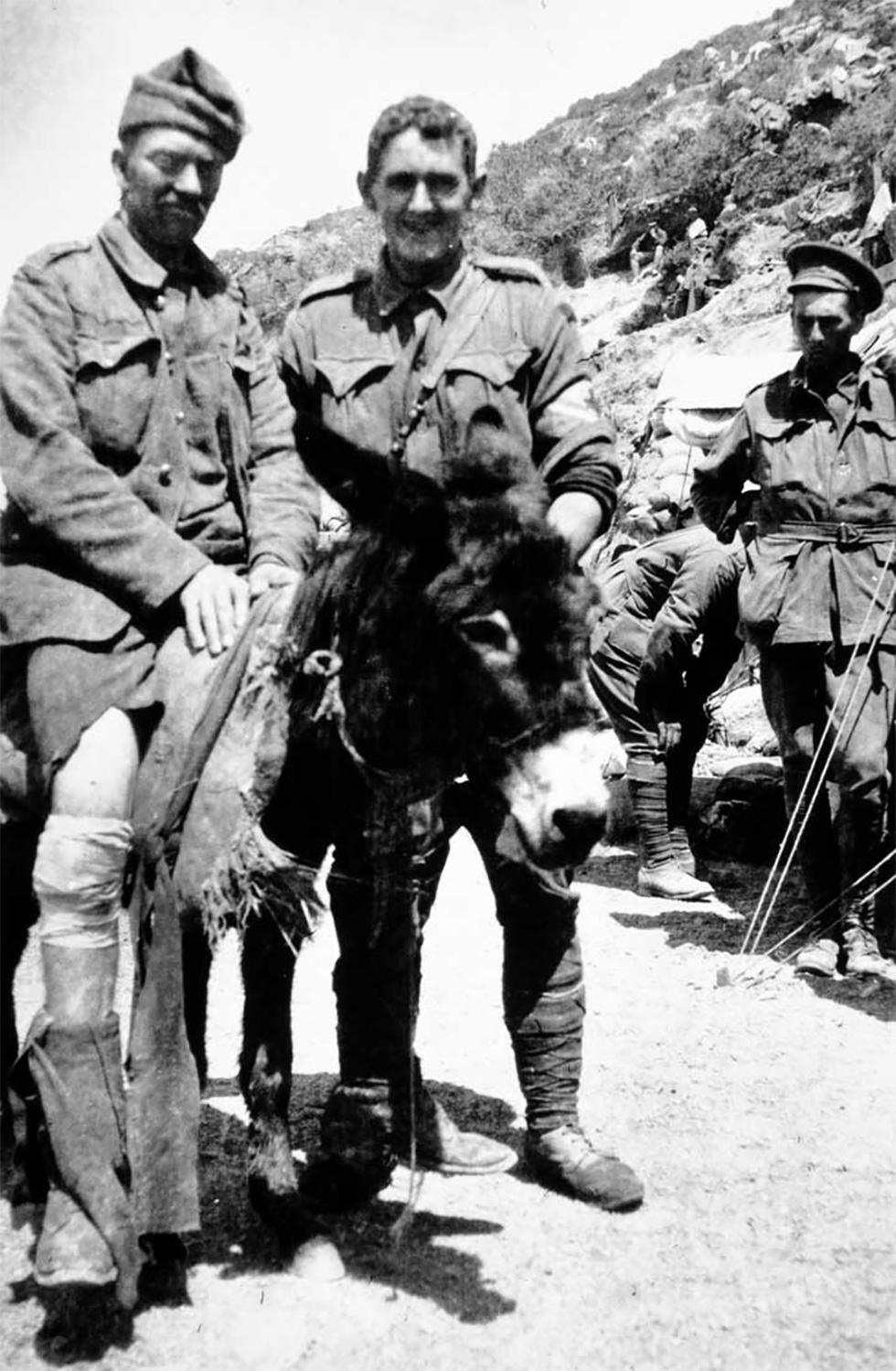
This photograph shows Private John Simpson Kirkpatrick – better known as John Simpson – leading a donkey carrying a wounded soldier through Shrapnel Gully, Gallipoli, during World War I. Nicknamed the ‘man with the donkey’, Simpson has become an iconic figure of the Gallipoli campaign, and is perhaps the best known Anzac.
John Simpson was a stretcher-bearer in the 3rd Australian Field Ambulance. He came ashore during the Anzac landing of 25 April 1915 and was killed less than 3 weeks later.
Simpson used donkeys to transport wounded men from the fighting in Monash Valley down to the dressing (first-aid) station at Anzac Cove. He was probably the first stretcher-bearer on Gallipoli to use a donkey to transport wounded men.
The donkey used by Simpson was landed on the first day of the Gallipoli campaign, one of a number brought ashore to carry water. Simpson later used a second donkey. It is believed that Simpson called the donkey in this photograph ‘Duffy’ – although other records indicate that either this or the other donkey was known as ‘Abdul’ or ‘Murphy’.
The legend that has grown up around Simpson suggests that he saved seriously wounded men. However, as the photograph makes clear, only those with relatively minor wounds could be brought back in this manner. Men with life-threatening head, chest or stomach wounds could not have ridden a donkey down the valley, even with Simpson’s assistance.


 ANZACS : the pain and the glory of Gallipoli
by
ANZACS : the pain and the glory of Gallipoli
by
 Gallipoli
by
Gallipoli
by
 Gallipoli
by
Gallipoli
by
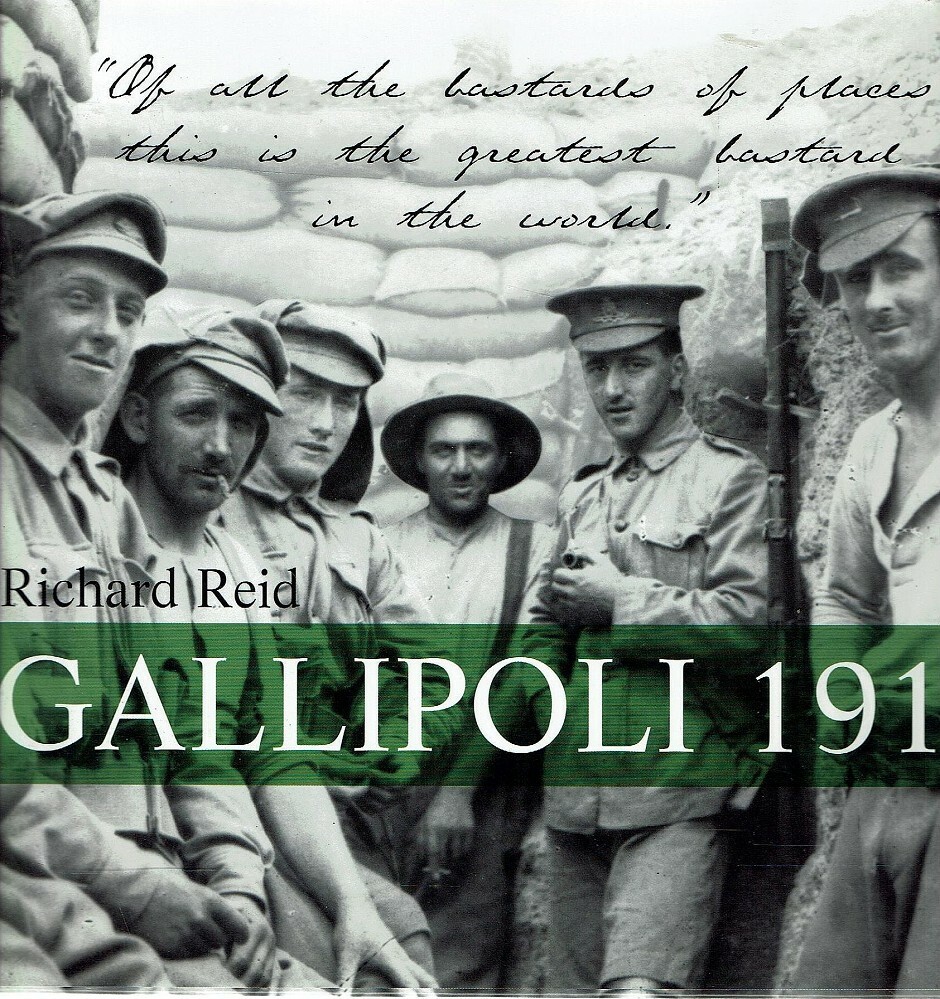 Gallipoli 1915
by
Gallipoli 1915
by
 Gallipoli and the Middle East, 1915-18
by
Gallipoli and the Middle East, 1915-18
by
 Gallipoli diaries : the Anzac's own story day by day
by
Gallipoli diaries : the Anzac's own story day by day
by
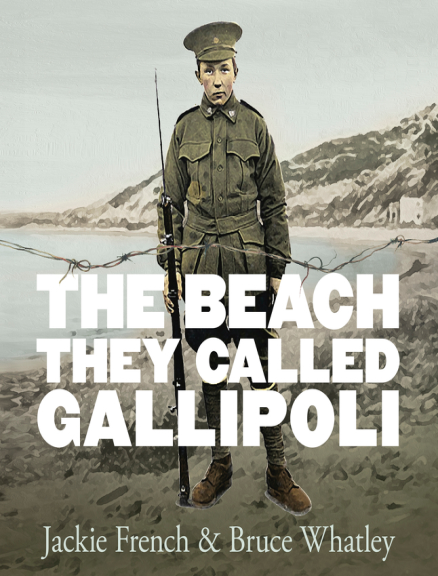 The beach they called Gallipoli
by
The beach they called Gallipoli
by
 The Gallipoli story
by
The Gallipoli story
by
 Young Anzacs : the contribution of Victorian schools to the Gallipoli Campaign 1915
by
Young Anzacs : the contribution of Victorian schools to the Gallipoli Campaign 1915
by